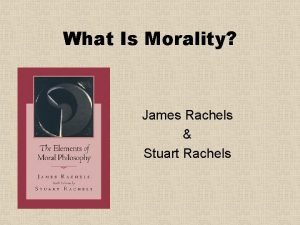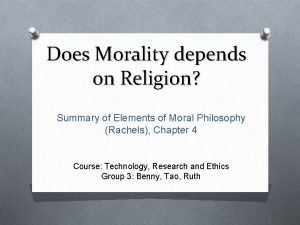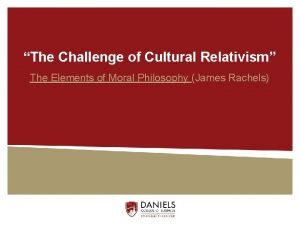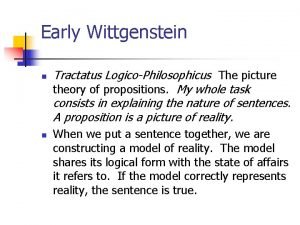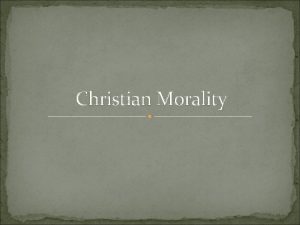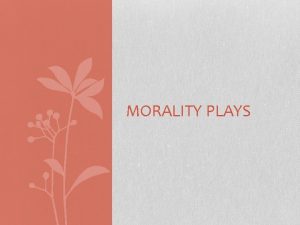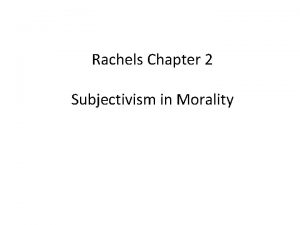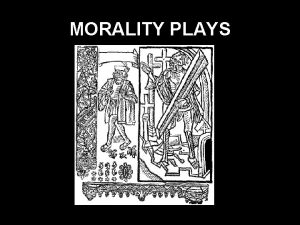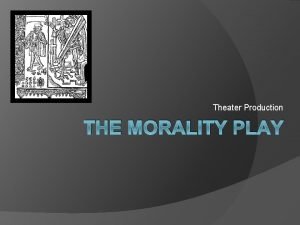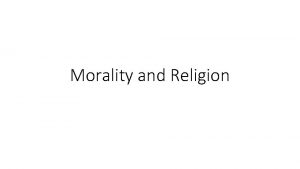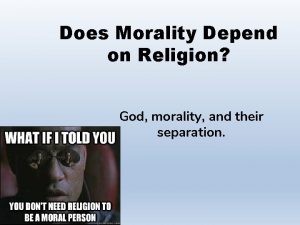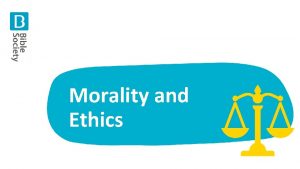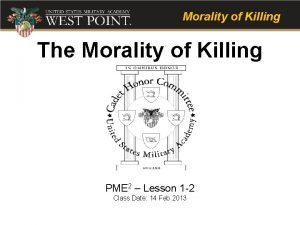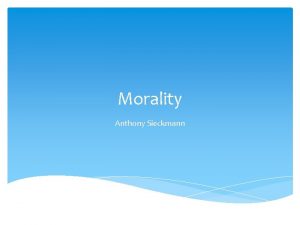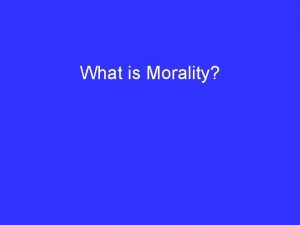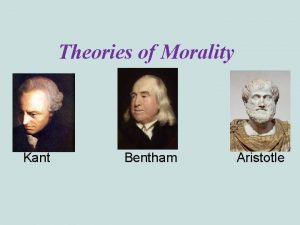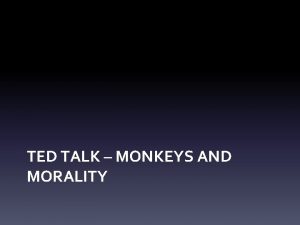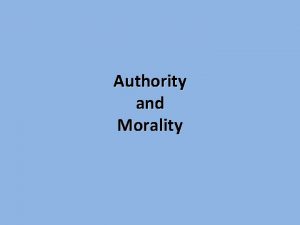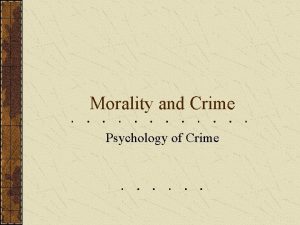What Is Morality James Rachels Stuart Rachels The


























- Slides: 26

What Is Morality? James Rachels & Stuart Rachels

The Problem of Definition § There are many rival theories, each expounding a different conception of what it means to live morally, and any definition that goes beyond Socrates’ simple formulation (“how we ought to live”) is bound to offend at least one of them. § Rachels proposes a ‘minimum conception’ of morality: a core that every moral theory should accept, at least as a starting point. FFirst, some moral controversies. .

First Example: Baby Theresa § Anencephalic infants: ‘babies without brains’ o Cerebrum, cerebellum, and top of skull are missing o Have a brain stem, thus autonomic functions (breathing, heartbeat, etc. ) are possible o Usually aborted in the US; otherwise, half are stillborn and usually die within days

Baby Theresa’s parents volunteered her organs for transplant. BUT. . . § Florida law forbids the removal of organs until the donor is dead. § Baby Theresa died after nine days. Her organs were too deteriorated to be harvested or transplanted. ? Should she have been killed so that her organs could have been used to save other children? F(Thousands of infants need transplants each year. )

Surprisingly few ethicists sided with the parents and physicians. § “It just seems too horrifying to use people as means to other people’s ends. ” § “It’s unethical to kill person A to save person B. ” § “What the parents are really asking for is, ‘Kill this dying baby so that its organs may be used for someone else. ’ Well, that’s really a horrendous proposition. ”

The Benefits Argument § If we can benefit someone without harming anyone else, we ought to do so. § Transplanting the organs would benefit the other children without harming Baby Theresa. Therefore, we ought to transplant the organs.

What about Baby Theresa’s life? ? Isn’t being alive better than being dead? FOnly if being alive allows one to ‘have a life’: to carry on activities and have thoughts, feelings, and relations with other people. ØIn the absence of such things, ‘mere biological life’ is worthless.

The Argument That We Should Not Use People as Means § It is wrong to use people as means to other people’s ends. § Taking Theresa’s organs would be using her to benefit other children. Therefore, it should not be done.

How is Baby Theresa being ‘used’? ? Vague sense of ‘use. ’ What does it mean? Violating Baby Theresa’s autonomy? FBaby Theresa has no autonomy to violate. She has no preferences about anything, nor has she ever had any.

The Argument from the Wrongness of Killing § It is wrong to kill one person to save another. § Taking Theresa’s organs would be killing her to save others. So, taking the organs would be wrong.

However. . . ? Shouldn’t there be an exception to the rule? FBaby Theresa is not conscious; she will never ‘have a life’; she is going to die soon anyway; and taking her organs would help other babies. ? Should we regard Baby Theresa as already ‘dead’? FPerhaps we should revise our definitions of ‘death. ’

Second Example: Jodie and Mary § Conjoined twins, joined at the lower abdomen; spines fused; one heart and one pair of lungs between them. § Without an operation to separate them, both twins would die within six months. § This would save Jodie, but Mary would die. § The parents refused permission for the operation, but courts okayed it. § Jodie lived, and Mary died.

The Argument That We Should Save as Many as We Can There is a choice: save one or let both die. ? Isn’t it plainly better to save one? FNot from the parents’ perspective.

The Argument from the Sanctity of Human Life § All human life is precious, regardless of age, race, social class, or handicap. § The prohibition against killing innocent humans is absolute. § Mary is an innocent human being. Therefore, she should not be killed.

However. . . FMary would not be ‘killed’ during the operation but merely separated from Jodie. Her death would be due to her body’s inability to sustain her life. FPerhaps it is not always wrong to kill innocent human beings. . . o If the innocent human has no future because she is going to die soon no matter what. . . AND. . . o She has no wish to go on living (perhaps because she has no wishes at all). . . AND. . . o This killing will save others who can go on to lead ‘full lives. ’

Third Example: Tracy Latimer § 12 -year-old victim of cerebral palsy, killed by her father with exhaust fumes while the rest of the family were at church. § Tracy weighed less than 40 lbs. and was described as “functioning at the mental level of a three-month-old baby. ” § Robert Latimer was sentenced to 10 years in prison. ? Did Mr. Latimer do anything wrong? Wasn’t killing her an act of mercy?

The Argument from the Wrongness of Discriminating against the Handicapped § Handicapped people should be given the same respect and the same rights as everyone else. § Tracy was killed because she was handicapped. Therefore, killing her was wrong.

However. . . FTracy was not killed because of her cerebral palsy but because of her pain and suffering and because there was no hope for her.

The Slippery Slope Argument If we accept any sort of mercy killing, we will slide down a slippery slope, and in the end all life will be held cheap. Where will we draw the line? ? What about other disabled people, the elderly, the infirm, and other ‘useless’ members of society?

Beware of slippery slopes! ! This kind of argument is all too easy to abuse. FIf you are opposed to something but have no good arguments against it, you can always make up a prediction about what it might lead to; and no matter how implausible your prediction is, no one can prove you wrong.

Reason and Impartiality § Moral judgments must be backed by good reasons. § Morality requires the impartial consideration of each individual’s interests.

Moral Reasoning § We cannot rely on our feelings, no matter how powerful they might be. § Our feelings may be irrational and may be nothing but products of prejudice, selfishness, or cultural conditioning. § Our decisions must be guided as much as possible by reason. § The morally right thing to do is always the thing best supported by the arguments.

How can we tell if an argument is really good? FGet the facts straight. FBring moral principles into play. Are they justified, and are they being correctly applied?

The Requirement of Impartiality § Each individual’s interests are equally important, and no one should get special treatment. § If there is no good reason for treating people differently, then discrimination is unacceptably arbitrary.

The Minimum Conception of Morality § Morality is, at the very least, the effort to guide one’s conduct by reason—that is, to do what there are the best reasons for doing— while giving equal weight to the interests of each individual affected by one’s decision.

The Conscientious Moral Agent. . . § Is concerned impartially with the interests of everyone affected by what he or she does. § Carefully sifts facts and examines their implications. § Accepts principles of conduct only after scrutinizing them to make sure they are justified. § Is willing to “listen to reason” even when it means revising prior convictions. § Is willing to act on the results of this deliberation.
 James and stuart rachels
James and stuart rachels Does morality depend on religion rachels summary
Does morality depend on religion rachels summary Moral cultural relativism
Moral cultural relativism Slave morality and master morality
Slave morality and master morality Slave morality
Slave morality Slave mentality
Slave mentality Raymond williams and stuart hall
Raymond williams and stuart hall Criminal profiling serial killers
Criminal profiling serial killers Russell odom and clay lawson
Russell odom and clay lawson Vẽ hình chiếu vuông góc của vật thể sau
Vẽ hình chiếu vuông góc của vật thể sau Frameset trong html5
Frameset trong html5 Thế nào là giọng cùng tên?
Thế nào là giọng cùng tên? Làm thế nào để 102-1=99
Làm thế nào để 102-1=99 Hát lên người ơi
Hát lên người ơi Lời thề hippocrates
Lời thề hippocrates Khi nào hổ mẹ dạy hổ con săn mồi
Khi nào hổ mẹ dạy hổ con săn mồi Tư thế worms-breton
Tư thế worms-breton đại từ thay thế
đại từ thay thế Quá trình desamine hóa có thể tạo ra
Quá trình desamine hóa có thể tạo ra Cong thức tính động năng
Cong thức tính động năng Thế nào là mạng điện lắp đặt kiểu nổi
Thế nào là mạng điện lắp đặt kiểu nổi Các loại đột biến cấu trúc nhiễm sắc thể
Các loại đột biến cấu trúc nhiễm sắc thể Vẽ hình chiếu đứng bằng cạnh của vật thể
Vẽ hình chiếu đứng bằng cạnh của vật thể Bổ thể
Bổ thể Phản ứng thế ankan
Phản ứng thế ankan Môn thể thao bắt đầu bằng từ đua
Môn thể thao bắt đầu bằng từ đua Thiếu nhi thế giới liên hoan
Thiếu nhi thế giới liên hoan
